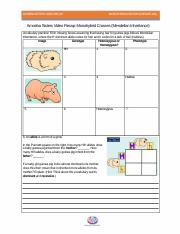Ever wondered how your eye color, hair texture, or even your predisposition to certain diseases are passed down from generation to generation? It’s all thanks to the fascinating world of genetics, and today, we’re going to explore the fundamental principles of inheritance using the engaging and informative videos created by the Amoeba Sisters. Buckle up, because we’re about to embark on a journey into the intricate realm of monohybrid crosses and Mendelian inheritance!

Image: www.coursehero.com
Imagine a scenario where a brown-eyed parent and a blue-eyed parent have children. What eye color will their offspring inherit? This simple question leads us to the heart of Mendelian inheritance, a foundational concept in genetics that explains how traits are passed from parents to their children. And who better to guide us through this journey than the brilliant duo, the Amoeba Sisters, whose animated videos make complex scientific topics relatable and fun.
The Amoeba Sisters’ Guide to Monohybrid Crosses
The Amoeba Sisters’ videos are a treasure trove of knowledge, and their “Monohybrid Crosses” video is no exception. This video delves into the basic principles of Mendelian inheritance, using a simple yet effective example: pea plants. Gregor Mendel, the father of modern genetics, meticulously studied pea plants, observing how traits like flower color and seed shape were inherited over generations.
Dominant and Recessive Alleles: The Key Players
The Amoeba Sisters clearly explain the concept of alleles, alternative forms of a gene that determine specific traits. Imagine each trait, like eye color or flower color, as a coin with two sides: one side represents the dominant allele, while the other represents the recessive allele. A dominant allele, symbolized by a capital letter (e.g., ‘B’ for brown eyes), masks the effect of the recessive allele, symbolized by a lowercase letter (e.g., ‘b’ for blue eyes).
Punnett Squares: Unveiling the Possibilities
The video then introduces the Punnett square, a handy tool that helps predict the possible genotypes and phenotypes of offspring resulting from a cross between two parents. The Punnett square is essentially a grid that visually represents the potential combinations of alleles from each parent.
For example, let’s consider a cross between a homozygous dominant parent (BB) for brown eyes and a homozygous recessive parent (bb) for blue eyes. The Punnett square would show that all offspring will inherit one ‘B’ allele from the brown-eyed parent and one ‘b’ allele from the blue-eyed parent, making their genotype ‘Bb’. Since ‘B’ is dominant, all offspring will have brown eyes, even though they carry the recessive allele for blue eyes.

Image: dihghmatoupolis.blogspot.com
Beyond Simple Traits: The Importance of Genotype and Phenotype
The Amoeba Sisters emphasize the distinction between genotype and phenotype. Genotype refers to the actual genetic makeup of an organism, represented by the combination of alleles, while phenotype refers to the observable characteristics, like brown or blue eyes.
Understanding Monohybrid Crosses: A Step-by-Step Approach
The video further explains monohybrid crosses, where we focus on a single trait. It demonstrates how to set up a Punnett square, identifying the possible gametes (sperm and egg cells) from each parent, and then filling the grid to calculate the probability of each genotype and phenotype in the offspring.
Beyond the Basics: Exploring Other Crosses for a Deeper Understanding
The video then moves beyond the simple case of homozygous dominant and recessive parents, showcasing examples of heterozygous parents (carrying both dominant and recessive alleles). It shows how the Punnett square can be used to predict the different outcomes of these crosses, highlighting the possibility of offspring exhibiting different phenotypes, even if both parents share the same trait.
Beyond the Videos: Bringing Mendelian Inheritance to Life
The Amoeba Sisters’ videos are an excellent starting point for understanding Mendelian inheritance. But to truly grasp the concepts, it’s essential to apply them to real-life scenarios. Here are some thought-provoking questions to consider after viewing the video:
- How does our understanding of dominant and recessive alleles impact our choices regarding family planning or genetic counseling?
- Can we predict the probability of inheriting certain genetic conditions using the principles of monohybrid crosses?
- How can the knowledge of Mendelian inheritance be used to improve agricultural practices and breed better crops?
Amoeba Sisters Video Recap Monohybrid Crosses Mendelian Inheritance
https://youtube.com/watch?v=8ZmVElW_ZiY
Concluding Thoughts: Embracing the Wonders of Genetics
The Amoeba Sisters’ videos are more than just educational resources; they’re a gateway to understanding the intricacies of life itself. Their engaging style and clear explanations make the world of genetics accessible, even for those who find science intimidating. By taking the time to learn about Mendelian inheritance, we unlock a deeper appreciation for the beautiful complexity of life and the fascinating mechanisms that shape our individual traits and those of future generations.
So, go ahead, explore the Amoeba Sisters’ videos, delve deeper into the world of monohybrid crosses and Mendelian inheritance, and join the exciting journey of unraveling the mysteries of our genetic code. It’s a journey that holds the key to unlocking the secrets of our past, understanding the present, and shaping the future.






